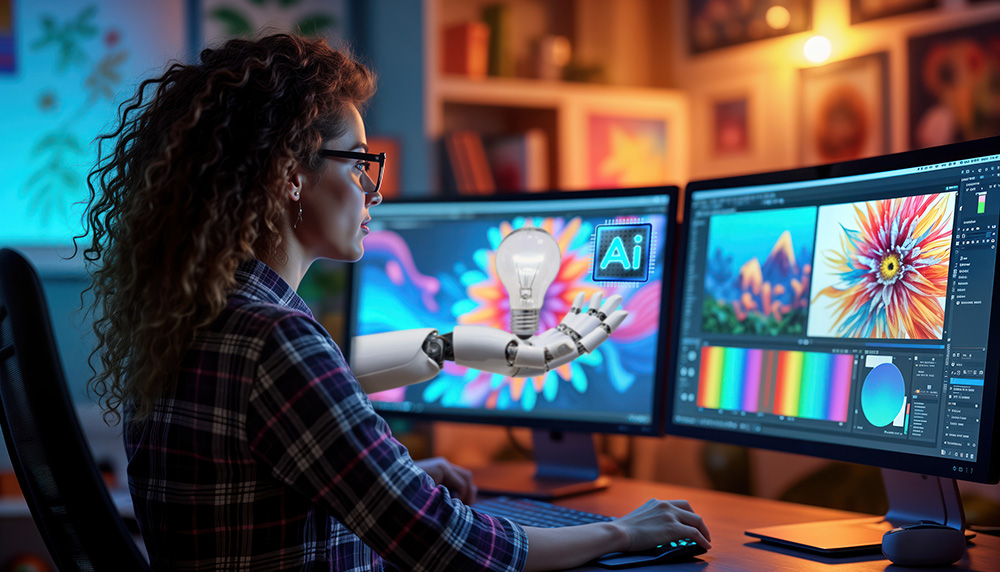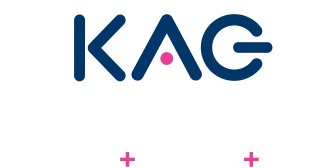
Graphic design has always stood at the intersection of creativity and technology. From the printing press to desktop publishing, from vector software to motion graphics, every technological leap has reshaped how designers work and what clients expect. Today, we are on the cusp of another profound transformation: the rise of artificial intelligence (AI). But what exactly is the role of AI in graphic design, and how should professionals and businesses navigate its growing presence?
This blog explores how AI is influencing the field of graphic design—from automation and productivity to creativity, ethics, and the future of the profession. Whether you’re a seasoned designer, a curious client, or a business owner considering how to stay visually relevant in a fast-moving world, this article is for you.
1. Understanding AI in the Context of Design
AI in graphic design refers to the use of machine learning algorithms, neural networks, and automation systems to aid or execute tasks that typically require human visual judgment, creativity, or aesthetic decisions. It doesn’t mean computers becoming “designers” in the human sense. Instead, AI augments workflows, speeds up iterations, analyzes trends, and offers intelligent suggestions based on massive data sets.
Common forms of AI in graphic design include:
- Image generation models (like DALL·E or Midjourney)
- Layout and template automation (e.g., Adobe Sensei in Adobe Creative Cloud)
- Logo and branding generators
- Smart cropping, background removal, and photo enhancement tools
- Typography pairing assistants
- AI-powered color palette tools
- Personalization engines for marketing design
- Data visualization automation
The role of Artificial Intelligence is neither entirely disruptive nor entirely complementary—it’s both. It depends on how it’s used and who’s using it.
2. Automation of Repetitive Design Tasks
Many parts of the design process are tedious, technical, and time-consuming. AI excels at handling such tasks with speed and precision, freeing designers to focus on conceptual and creative thinking.
Examples:
- Background Removal & Masking: Tools like CorelDRAW Graphics Suite “AI Background Removal Tool” or Photoshop’s AI Selection streamline image editing.
- Batch Resizing: Platforms like Figma and Adobe XD now use Artificial Intelligence to auto-adjust layouts for different screen sizes or social platforms.
- Content-Aware Fill: Photoshop’s AI capabilities can seamlessly replace parts of an image based on surrounding pixels.
- Font Recognition: Tools like WhatTheFont use machine learning to identify and suggest similar typefaces instantly.
These features reduce production time and minimize manual labor—especially useful for agencies and in-house teams with high-volume design demands.
3. AI as a Creative Collaborator
While critics often claim that AI lacks imagination, recent developments suggest that Artificial Intelligance can generate surprisingly inventive ideas—especially when guided by skilled human input. The shift is not from creator to replacement, but from tool to collaborator.
AI Image Generation:
Tools like Midjourney, DALL·E, and Stable Diffusion can generate original artwork, illustrations, and conceptual mockups from text prompts. Designers use these tools for mood boards, style explorations, and even as raw material for further refinement.
Typography and Layouts:
Tools like Looka, Fontjoy, or Colormind use AI to suggest combinations that follow principles of good design. They’re useful for brainstorming or ideation, not final design.
Generative Branding:
Artificial Intelligence can create preliminary branding assets in minutes, which small businesses might use as a starting point. But while the execution is quick, it still often lacks the depth of human-led brand strategy and storytelling.
In this way, AI doesn’t replace the designer—it expands what a designer can do, how fast they can iterate, and how many concepts they can test.
4. Ethical Considerations in AI-Generated Design
The growing presence of AI raises important ethical questions in the graphic design world:
4.1 Copyright & Intellectual Property:
Many AI models are trained on publicly available images, artworks, and illustrations—often without the creators’ consent. This creates a murky legal and ethical landscape around ownership.
- Who owns an AI-generated image?
- Can a brand use AI-generated assets commercially?
- What happens when AI mimics an artist’s style?
The answers remain unsettled. Some AI image platforms allow commercial use; others impose restrictions. Designers should carefully read usage terms and avoid relying solely on AI assets for client work unless rights are clear.
4.2 Authenticity & Human Touch:
Design is not just about visuals; it’s about communication, culture, and emotion. Human designers understand nuance, context, tone, and audience in a way AI cannot (yet). There’s a risk that overreliance on AI tools could lead to generic, soulless, or derivative work if not critically evaluated.
4.3 Job Displacement:
Junior-level roles, such as production design or entry-level graphic layout, are most at risk of automation. This demands a shift in how designers position themselves—less as technicians, more as thinkers and creative strategists. Education must evolve to reflect that.
5. AI and the Democratization of Design
One of the most significant impacts of AI in graphic design is accessibility. AI-powered platforms enable non-designers to create passable (sometimes impressive) visuals with minimal skill or training. Microsoft Designer, and Adobe Express all provide pre-built templates enhanced by automation.
For small business owners, entrepreneurs, or marketers with limited budgets, this is empowering. For professional designers, it may feel like the field is being flooded with amateur content. But this democratization isn’t necessarily negative.
The Design Gap:
Many businesses historically couldn’t afford professional design. AI tools fill that gap. But as those businesses grow and face more competition, they usually graduate to professional, strategic design services.
Value Shift:
As basic design becomes more accessible, professional designers must emphasize value-added services like:
- Brand strategy
- Human-centered design
- Storytelling
- Custom illustration or photography
- UX/UI research
- Complex, multi-platform campaigns
The future isn’t “design vs. AI”—it’s “templated design vs. custom human insight.” While AI image generators can be a tempting way to fulfill business needs on a budget, it’s essential to carefully weigh the potential benefits against the challenges and costs. For small businesses, particularly those operating with limited resources and expertise, relying solely on AI might not be the most effective or cost-efficient approach. A hybrid strategy, where AI is used for specific tasks like brainstorming or generating basic drafts, combined with professional design for crucial elements like brand assets and marketing campaigns, may be the most advantageous approach to balancing budget considerations with quality and long-term brand impact.
6. Limitations of AI in Graphic Design: The Reality Behind the Hype
Despite the growing buzz around AI tools in design, not all of them live up to expectations. While platforms like DALL·E, Looka, and Fontjoy are widely promoted as revolutionary tools, many designers find them deeply underwhelming in practice.
A Professional Perspective
For experienced designers, experimenting with these tools can often feel like a waste of valuable time. Here’s why:
- Time-Consuming Learning Curves
AI tools often require you to learn a new way of thinking—through prompts, unfamiliar UIs, or unpredictable workflows. This learning investment rarely pays off when the output is poor or unusable. - Underwhelming Results
Tools like Looka and Fontjoy offer only a narrow range of style combinations and often produce unimaginative or mismatched pairings. DALL·E’s image generation might be flashy at a glance, but closer inspection reveals issues that make the visuals impractical for real-world use. - Lack of Conceptual Depth
These tools tend to rehash popular or formulaic designs. If you’re looking for fresh creative direction, unexpected juxtapositions, or rich conceptual exploration—they won’t get you far. They’re better for placeholders than polished brand assets.
Image Generation’s Most Common Failings
One of the most hyped uses of AI is for generating images from text prompts, but this is also where it shows its most glaring limitations.
- Mangled Hands and Faces
AI still struggles with human anatomy—especially hands, fingers, and eyes. The results can be distorted or eerie, making them unusable for professional marketing or branding. - Unreliable Typography
Text within AI-generated images is often incoherent. Since the models don’t understand written language the way humans do, signs, posters, or UI mockups with “text” are usually gibberish. - Strange Compositions
Object relationships often don’t make sense. A shadow may fall the wrong way, items may overlap incorrectly, or spatial depth may be inconsistent. - Uncanny or Incoherent Style
AI-generated art often blends styles or references awkwardly. The aesthetic is neither cleanly modern nor intentionally retro—it’s just off.
These flaws severely limit the usability of AI art in client projects, branding, editorial design, or any work where polish and precision matter.
Where It Can Be Useful
Still, AI-generated visuals can have some utility:
- Rough Composition Sketches: Useful for quick brainstorming or layout exploration before diving into high-res mockups.
- Moodboarding: AI can help define a visual tone early in the creative process, giving clients a sense of a style or direction.
- Placeholder Images: Especially during UX/UI wireframing, AI visuals can stand in until real content or photography is developed.
AI should be treated as a rough-sketch assistant, not a reliable illustrator or photographer. It’s still a long way from replacing the nuanced output of trained professionals.
7. The Changing Role of the Designer
With AI now able to handle some design tasks (and even offer ideas), what’s the new role of the designer?
From Creator to Curator:
Designers are increasingly curators of options—generating multiple versions via AI, selecting the best, and refining. The skill becomes about judgment, refinement, and direction.
From Technician to Strategist:
AI can produce images, but it can’t understand a brand’s mission, target audience, or long-term goals. Designers who can tie visual work to business objectives will remain in high demand.
From Software User to Creative Director:
Instead of spending hours clicking through menus, designers guide AI tools with prompts, concepts, and critiques. Prompt engineering becomes a new creative skill.
From Soloist to Collaborator:
Designers now work alongside AI, developers, UX teams, and data scientists. Multidisciplinary collaboration is key to delivering sophisticated, AI-integrated experiences.
8. Preparing for the AI-Driven Design Future
Whether you’re a freelancer, agency, or brand-side designer, now is the time to embrace AI—not as a threat, but as a powerful tool.
Tips for Designers:
- Experiment with Tools: Try DALL·E, Firefly, Canva Magic, or Midjourney to understand their strengths and weaknesses.
- Learn Prompt Crafting: Writing prompts that produce useful visual output is a skill. Practice iterating and refining.
- Stay Updated: AI evolves rapidly. Subscribe to design and tech newsletters, join communities, and attend webinars.
- Develop Strategic Thinking: The more irreplaceable your thinking is, the less your tasks will be automated.
- Build a Strong Portfolio: Show your thought process, not just outputs. Explain how your work solves problems.
- Be Transparent with Clients: If AI is part of your workflow, let clients know. Many appreciate the efficiency, but want to ensure originality.
9. The Future: Co-Creation and Human-Centered AI
The future of AI in graphic design isn’t about one replacing the other—it’s about partnership.
We’re entering a phase of co-creation, where designers and AI work together, not in conflict. The best results come when human insight guides AI, when creativity is amplified by computation, and when ethical design thinking underpins the use of powerful tools.
As AI gets better at mimicking form, the value of original ideas, empathy, storytelling, and cultural intelligence only increases.
Conclusion
Artificial intelligence is a tool that’s reshaping how businesses create and deliver visual content. In the design world, AI helps speed up repetitive tasks, generate layout ideas, and support rapid prototyping. But it’s not a one-click solution for thoughtful, effective design. Especially when it comes to image generation or brand development, current AI tools still fall short of the insight and polish needed for real-world marketing.
For small businesses, startups, and growing companies, AI in design opens up new opportunities: quicker turnaround times, more budget-friendly creative options, and faster testing of marketing ideas. It can be a valuable part of your toolkit — helping you visualize concepts, streamline feedback cycles, and stay agile in competitive markets.
But here’s the key: while AI is great at speeding things up, it still takes a trained eye and strategic thinking to turn those ideas into compelling designs that connect with customers and build your brand.
In short, AI makes good design more efficient — but smart, purposeful design is what moves your business forward. With the right partner, you can combine both.
Let’s Bring Your Brand to Life
If you’re a small or midsize business looking to stand out, or a startup building something new, we help you bring your ideas to market with design that’s fast, thoughtful, and scalable. We blend professional creativity with smart tools — including AI where it adds value — to deliver visuals that actually work.
👉 Let’s chat about your goals and how design can help grow your business.

